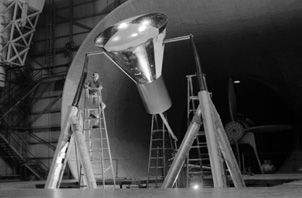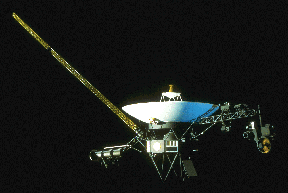Click on image for full size
Courtesy of NASA
Related links:
Administrator Goldin's Statement on NASA's Fortieth Anniversary
News story originally written on October 2, 1998
This is Administrator Goldin's speech about NASA's 40th birthday:"Forty years ago, in 1958, the National Aeronautics and Space Administration was created with the boldest and most noble of missions: to pioneer the future. We were told to explore new frontiers and enhance life here on Earth. We were asked to instruct; we were expected to inspire. Forty years later, thanks to an American public with an unquenchable thirst for knowledge and a relentless sense of adventure, NASA has delivered.
Think about this: Forty years ago, jet passenger service was a novelty. Global communications meant a telephone line laid across the bottom of the Atlantic Ocean. When NASA was first getting started, the only way to track hurricanes was to fly planes directly over and into the storms. Our universe -- even the cosmic neighborhood just above our atmosphere -- was a mystery. In 1958, sending humans to the moon was pure science fiction.
But we dared to dream. We imagined what could be possible. And then along with our partners in industry and academia, we went to work.
In 1998, hundreds of millions of people ride American jets each year and new designs for flight go higher, faster and farther than ever before. Global space communications have helped create a global community. Weather satellites can detect the early evolution of an El Nino condition months in advance. There are still many mysteries to be solved, but Voyager, Galileo, the Hubble Space Telescope and other planetary and astronomy missions have circled neighboring planets, given us our first direct evidence that black holes exist, and begun to peer back at the very beginning of our universe. A space program that is forty years old has sent astronauts to the moon, robots to Mars, spacecraft to the furthest reaches of our solar system, and soon will help build the International Space Station. And for every step we take out there, we have contributed to a better quality of life right here. That is true whether it be the "spin-off" technology that helps us detect breast cancer earlier, or the child who looks up and knows that no longer is the sky the limit; it is the stars and beyond.
NASA has had a great forty years, but what the American people can be most proud of is this: when it comes to pioneering the future, we are just getting started. What will always define this aeronautics and space program -- and this country -- is our firm belief that there will forever be something to invent, somewhere to discover, someplace to visit.
Rest assured, NASA will do its best in the next forty years to find out just what and where that will be."















